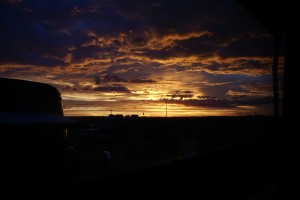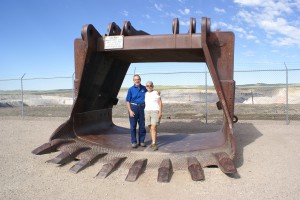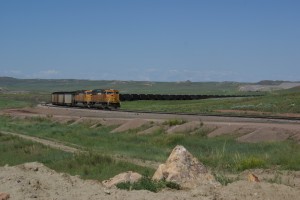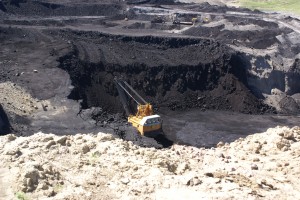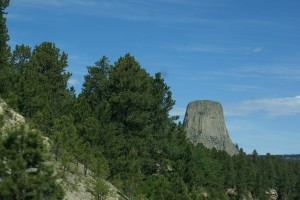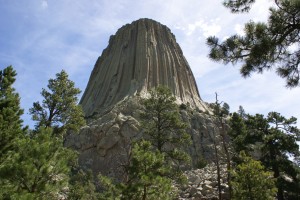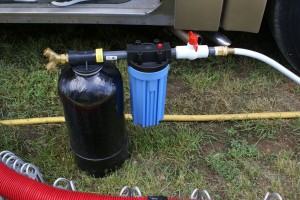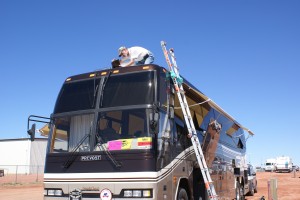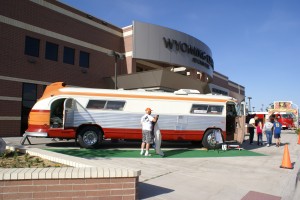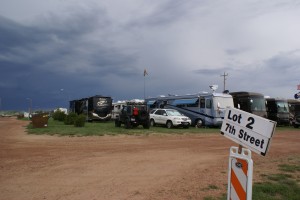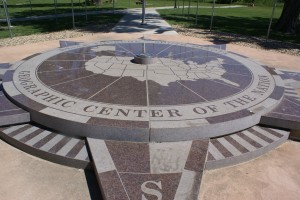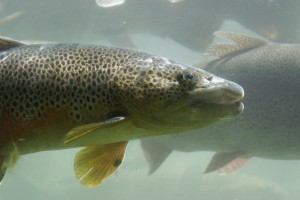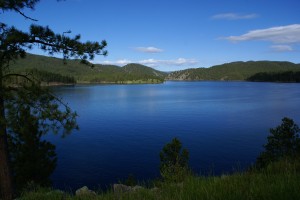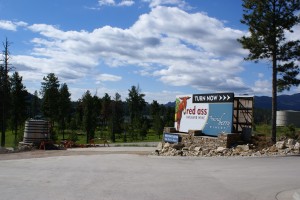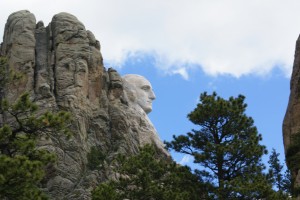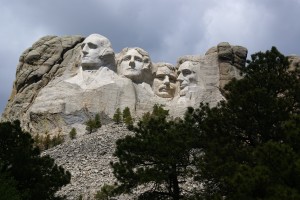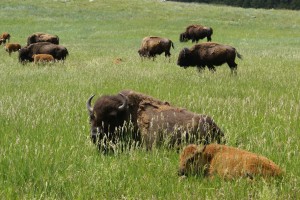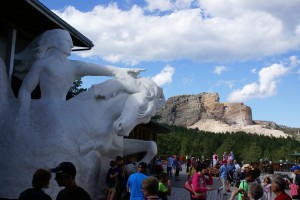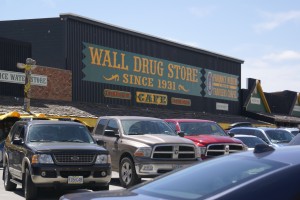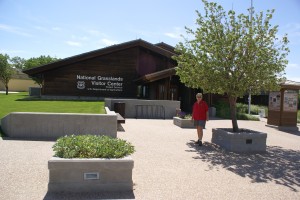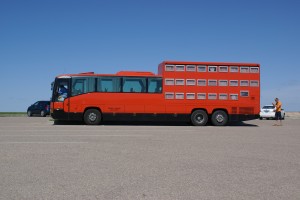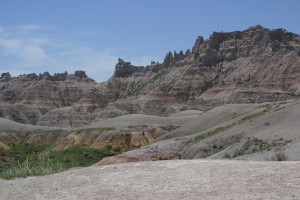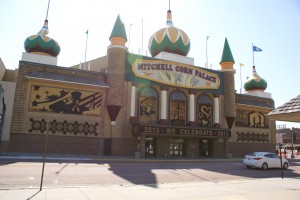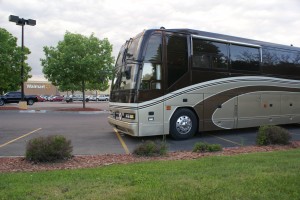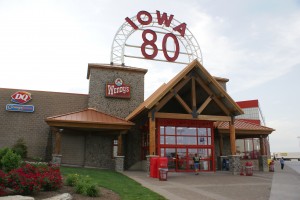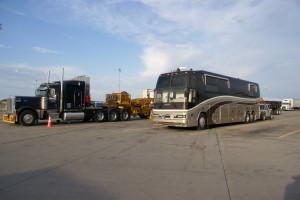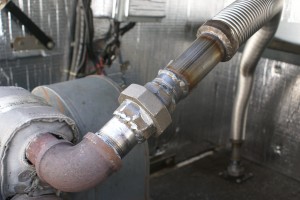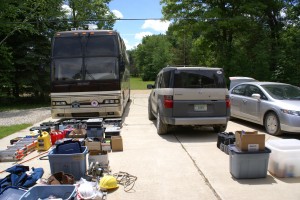Linda was up early this morning and went for a sunrise walk. Perhaps she was too excited to sleep because it was her birthday, but this is the 53rd Escapade and the 35th anniversary of the founding of the Escapees RV Club, so it could have been that. When she got back I brewed up some Jamaica Blue Mountain coffee (from Irene’s Beans in Milford, MI) and she opened her birthday present. Linda now has her first “cowgirl” shirt! She liked it so much that she made blueberry pancakes for breakfast with real, fresh blueberries and real Michigan maple syrup. (If you are thinking that I should have prepared breakfast for her, let me state that in the past I would have, and could have, done this but she is the resident WFPB culinary expert, and I have basically stayed out of the kitchen, and out of her way, since we started down this path two years ago.)
We got a call from our son who was checking on our house. Linda had asked him the day before to check our answering machine because it wouldn’t pick up when we called. It turned out that we didn’t have a dial tone, but our Internet connection appeared to be OK. He said there had been a lot of rain this past week, so that may be the reason. Our phone and data service come over the same wire, so I’m not sure that is the problem. We decided to wait a few days and see if it clears up. If not we will have to contact AT&T.
We had more coffee at 9 AM at the WiFi Cafe and more conversation with Charles Martin. We returned the defective Camco hose and got a replacement. Their analysis was that the metal sleeve had not been swaged properly which is why the barbed fitting did not stay in. While we were there we looked at the Camco Genturi genset exhaust stack. This is an auxiliary exhaust stack that fits on the end of the generator tailpipe and carries the generator exhaust up past the roof line of the RV. It’s made of 3” PVC in 4 foot sections, so it can be taken apart and stored. A tailpipe extension curves up into the base of the 3” pipe with room to draw in cooler air around it and creating a Venturi effect, thus the name of the product. This is a fairly easily duplicated design; the main reason to buy it is that you don’t have to source all the materials and make it yourself. The vertical pipe has to be supported somehow, and suction cups are one of the options. The vendor suggested getting large ones from Harbor Freight that are normally used for handling windshields and other large pieces of glass. If/when I build one of these, I would like to be able to hook it onto the gutter rail where the roof starts, but the large suction cups are an interesting idea, although I am not too keen on that idea with the new paint on the coach. Our Aqua-Hot exhaust exits out under the driver side of the coach right next to the generator exhaust, and I have considered building a double stack that hooks to both of these. In both cases, however, I have to be careful not to restrict the exhaust flow and create back pressure.
We walked through the vendor area again and talked to Sean at WiFi Ranger about the factory default reset we got when we turned the power off and back on. I also bought a roof mounting bracket for our WiFi Ranger Mobile. Linda bought a silicone cooking sheet for use in the microwave from RV SpaceSavers. We stopped and talked briefly to Nick & Terry Russell of The Gypsy Journal and gave Nick a copy of the February 2013 issue of Bus Conversion Magazine. Until a few years ago, Nick and Terry lived in an MCI bus that Terry had converted. (Nick is famous for not knowing how to use tools.) We talked to a vendor who provides mobile black/grey tank cleaning service, but deferred signing up. We also chatted with a satellite TV vendor who felt strongly that Direct TV was a far superior choice to Dish Network, especially if we were also going to use it at home. She confirmed that Moto-Sat had gone out of business and that RF Mogul was started by former Moto-Sat employees. We discussed the possibility of using a fully-automatic open style multiple-satellite dish on a tripod or other mount rather than having it attached to the roof. She seemed skeptical, but did not see any fundamental reason that it wouldn’t work. (In fact we have seen a lot of open style satellite TV dishes mounted on tripods or sitting on the ground, although most of them are manual dishes, not automatic.)
After our jaunt through the vendor area, we visited “The Row” to get our “bingo” sheet filled in but ended up talking to many of the chapter and C-BOF representatives. We finally met Steven Gullette from the HFH BOF, with whom we had exchanged many e-mails in the last few months. He will be one of the co-leaders on the build in Sheridan in a couple of weeks. We chatted with Lou Petkus, K9LU, and signed up for the newly formed SKP Photographers BOF (no charge). We also talked to the Elks BOF and found out that we can join the Gillette lodge while attending Escapade, so we took some information and an application form. The initiation is Friday evening.
We got back to the coach around 12:45 PM and grabbed a quick lunch before running some errands. We went back to the Boot Barn to exchange Linda’s new shirt for a different size, and had to join their “loyalty program” in order to do the exchange. The manager had to approve the exchange and was a bit surly. We will not be shopping there ever again. We also mailed an anniversary card to our son & daughter-in-law. Linda received a birthday call from her sister and a video birthday greeting from our son, daughter-in-law, and granddaughter. In many respects, RV life is just like regular life.
We attended the opening / welcome ceremony at 3 PM and were delighted to see and hear from Kay Peterson, SKP #1. Dinner was leftover risotto with the rest of the Lawrence Elk black currant wine from Prairie Berry Winery, and both were excellent. I was sorry that they were both gone, but there’s more where they came from.
We went over to the Wyoming Center at 7 PM for the Door prize drawings followed by the Rivoli Review for the evening entertainment. They do a good show, with lots of energy and humor, although the patriotism was laid on fairly thick, and there were moments that were just plain jingoistic and inappropriate. Although many of the attendees were enthusiastic about their show, there were plenty of folks sitting on their hands who were clearly not so pleased.
